#this would be a scene between two characters on the second book when our main characters split up
Explore tagged Tumblr posts
Text
"His name is Burt." He stated matter-of-factly. "B U R T Burt."
"Burt?" He questioned, scooping the plump cat into his arms. "Isn't that usually spelled with an 'E'?"
The cat was very tolerable of being carried on ones shoulder as if trying to burp a baby. This was not how Matthew had picked the cat up, and Burt with a 'U' was very quick to twist his body out of being carried with his stomach exposed. Matthew hissed at the sting of claw marks poked into his skin like sickening acupuncture, and Burt hissed back, poofing up his tail and running off to find somewhere dusty to hide.
The man only laughed and handed him a limp, lanky orange cat with much shorter, courser fur.
"Here. This is his brother-" he rolled his eyes and explained they were from a litter of 'domestic shorthairs' despite the grey cats long rabbit-soft fur. Mutts, figures, "-he's much more tolerant than the other."
Matthew took the lanky cat into his arms, pleased as the fake tabby stretched out in his arms, purring a loud wheezing purr, and insisted on incessantly rubbing his face against his red rosary. Trying to hide the swell in his heart at the cat in his arms, he asked the name.
"Ernie.
"Ernie? A name with two 'E's...?" He chided.
"Yes." Michael turned to him as if this was the most obvious thing in the world. "That's where the 'E' went."
#have some drabbles#if I ever write this book#this would be a scene between two characters on the second book when our main characters split up#seid#matthew
8 notes
·
View notes
Note
I feel like I’m going crazy because I keep on seeing people fantasy cast actors in their 30s for Marius and I just assumed he would be aged up since our main vamps were. Why is everyone seeing him as looking the same age as Lestat? I just think a lot of the story would fall flat if he appears to be mid 30s or even mid 40s. This goes for his mentor-relationship with Lestat, but more so for his relationship with Armand. What are your thoughts?
Also, I have a Lestat query. Second season made me Armand obsessed but when I first saw season 1, I was initially intrigued by Lestat. When I first watched season one I had not yet read the books. I read through TVA in between seasons. So when season 1 episode 5 happened, I didn’t feel any certain way. I chalked it up to gothic storytelling. Having now read the books and getting a better idea for who Lestat is, I can now understand why people were/still are very upset by it. But I’ve even seen non book readers extremely upset by it, which I can understand to a degree. It’s pretty atrocious what he does. But it seems to have made non book readers hate hate hate Lestat to a degree that is rather unfortunate. It seemed in season two the writing was trying to soften it a bit with his, what I felt was heartfelt apology during the trial and their reunion scene. But it’s been clear to me there is a large contingent of fans who still LOATHE him, point blank. I’ve always seen this show as an ensemble piece, but it’s clear Lestat will take center stage next season. Do you think the writers will succeed in getting people to appreciate Lestat and want to hear his story and sympathize with him or did episode 5 do more damage than intended to how his character will be perceived going forward?
I don't think the writers need to "get" people to like Lestat - I think Lestat is liked plenty already. :)
There is just this very loud but actually not that large subset of the fandom (believe me, once you block a bunch you realize just how few they actually are!) who are applying their morality olympics to this character because of 1x05, and who refuse to follow the shifts in the tale - of which we had some, and of which there will be more.
That's, ultimately, gonna be their problem.
The show follows the books. The shift to Lestat was always set to come.
Season 3 will be make or break for a lot of the old fans still around I think. Because it's not only Lestat who is "not Anne's Lestat", by Sam's own words - we'll also have the introduction of Gabrielle and Marius (likely) as well as Akasha (also likely I think) next season, and those characters will need to land.
Episode 5 did damage the fandom and the story - it brought in elements for an arc that is in Rolin's head imho, namely the Amel awakening arc already, thereby, due to the way they did it, destroying some of the arcs in the books - and THAT will have repercussions through all that follows.
Because there are arcs in the books. Arcs of self-acceptance, and mourning, and grief.
I know there's this huge discussion on Twitter rn re show!Claudia not having to die - and you know? They're right! Show!Claudia would not have needed to die - her fate was not as inevitable as her book counterpart's was. And yes, of course one can point and say: "Claudia had to die because Michele died, and that is why IWTV exists and why she had to die in the books"... but ... and in order to fix why she had to die, he went and chipped at other arcs/relationships, here most notably Louis/Armand and Louis/Lestat - and Lestat/Armand.
The relationships will never be the ones in the books because of those changes.
Nonetheless - they are doing the books. In their own way.
And - to get back to your initial comment :) - even in the books Marius was older than 30 :))
I do hope that both Gabrielle and Marius will be over 50, tbh. The Dark Gift rejuvenates, yes, but not that much, and the actors do have to be older than Lestat :))
In fact, I could easily see the casting for those three (Gabrielle, Marius and Akasha) being the reason for the delay in filming... because, as said - these three HAVE to hit.
But, given Rolin's hand at casting... I'm actually not too worried :)
#Anonymous#ask nalyra#amc iwtv#iwtv#amc interview with the vampire#interview with the vampire#fandom woes#marius de romanus#akasha#gabrielle de lioncourt
23 notes
·
View notes
Text
🔮 ⤷ Eldritch Awakenings | Main Quest Review
Plot spoilers for the main quest below the cut. Avert your eyes!
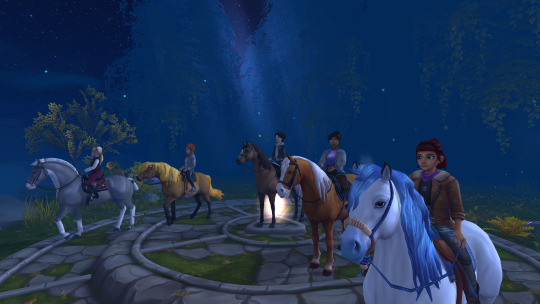
Plot: I think the opening to the quest was one of the best we've had in a while. It wasn't just going up to one of the characters and them remembering your existence since they've been stagnant in Fort Maria for two years. Being alone for that first part was really quite cool, and I think reinforced MC's own individual part in this story, and not just as an accessory to the Soul Riders and the Druids. Taking us on a slow ride through MC's journey and growing responsibility as the fifth Soul Rider through mirages of important characters (istg when Elizabeth appeared, I audibly gasped) felt like a genuinely cool way of preparing us for what's ahead, and what MC's position actually means.
I'm not sure if it's ever been mentioned before, though I probably missed it, but I didn't know Aideen's Ascent is the place where Aideen first stepped on Jorvik? I thought that was a really cool place to have the beginning of this quest take place. To stand on the place where light first touched Jorvik, and then look out into the ocean during the vision scene and see the physical manifestation of darkness breaking loose? HELL YEAH. The imagery is *chefs kiss*.
After following Jessica through the portal and coming up into Guardian's Dale (after using various bits of magic from our Soul Rider training), all four Soul Riders are just sorta hanging there. I'll be honest, I kinda didn't like that bit...??? I completely get that they need to get MC to play a big part in this whole thing, but I don't think that necessarily means just handing the entirety of Jorvik's fate over to us whilst the other four just sit on the sidelines (but, hey, what's new?). They kept mentioning over and over throughout this quest that 'together we're unstoppable', but WE'RE VERY MUCH STOPPABLE IF YOU'RE UP THERE BABE. It would be really nice to get a bit of balance across the group, yknow?
But!! Before we can get them down (which apparently we could have done before everything went to shit), we're invited to touch the Light Ceremony Book. Y'know, the big book that's currently dangerously floating in a pool of dark magic? And then, uh, we just do? Well played, MC.
Queue: "Oh god, oh no!! This has all gone horribly wrong!! MC, I believe in you, you can get us down! And then we can help you!!"
But before I get too caught up in that, allow me to just touch on THE DEATH OF MR SANDS???
Now THIS caught me off guard. Whilst I expected that Sands' death would happen eventually (I would have assumed during the final great battle or something), I wasn't prepared for it to happen at this point in time. Honestly, I'm not sure how I feel about it! I think I've grown too attached to Sands as a character throughout the various games and the books, his history and his motives etc, and am kinda sad to see him go. I think it definitely poses an interesting relationship now, as we saw, between the Dark Riders and Darko, the former of which clearly does not want to work with the latter. Wonder how this dynamic will develop in the future?
Okay, so back to saving our besties.
Avoid the various Dark Rider magic, press E, repeat.
Okay got em down, all good.
Queue: "That was awesome MC!! Okay, here's the plan. ALL OF US will distract the Dark Riders whilst YOU AND YOU ALONE DEFEAT GARNOK!! Because together we're unstoppable!! You'll do so awesome!! We believe in you!!
So, okay. I understand that there is only so much they can do in terms of fight scenes and how MC plays a part in that, in terms of keeping it PG and actually playable in the realms of SSO's mechanics, but come on! You're telling me the Big Great Battle you advertised was just 30 seconds of running around in a circle pressing E? Basically dumbed down to "hit this thing!", "now hit this thing!", "one last time, hit this thing!", "OMG you did it!! Garnok's gone now :)"
Though, to be completely honest, another massive thing that shocked me was us having to destroy the Light Ceremony Book. Maybe I'm just too caught up in the lore of the novels (my beloveds), but it's clear that that thing is so valuable, and it's just like, gone now.
Not only that, as Darko mentioned, whilst we may have stopped Garnok from breaking through right now, we've also just destroyed the one way to stop him from doing it again. Which is um, uh oh.
So, Darko wants a fight (and I fully expected us to start fighting him again) BUT no :/ everyone's just too tired to do anything else right now, and so the Dark Riders (after bitching about Darko briefly) ride off into a portal, and we ride off into the sunset for a lil cosy campfire.
And I liked the campfire scene. It very much reminded me of the Saving Anne quest :( Like, they all just want their normal lives back, and yet they're fully aware that they will never fully achieve that? That just :(( I love them really, I promise.

Visuals:
There's no doubt about it that the team went to town on how this quest looked. There were so many new animations, visual effects, and just the general atmosphere felt really nice.
In terms of character animations, I believe we got some new ones for the Dark Riders! The way Katja and Jessica glanced at each other was SUCH a fun little addition to it. No-one was just stood there like "🧍♂️🧍♂️🧍♂️"
The animation for when Darko drags Mr Sands into the portal?? HELLO?? PERFECTION. Bro literally called him frail and decrepit and proceeded to grab him by his collar and throw him into a death hole.
The way the Soul Riders and their horses were being held up in those orb things looked genuinely quite cool. Also very reminiscent of Anne in Pandoria :( We also got another instalment of Shocked Alex™, which I thoroughly enjoyed.
I could be wrong here, but the vision scene right at the beginning looked illustrated? And it looked SO good, I mean, that whole scene was just perfectly executed. The way the effects distorted everything and how we just watch as Garnok breaks out of the water?? MMM.
I would also like to acknowledge the SOUND EFFECTS?? There was a particular moment where Linda screams, and that took me by surprise icl.
Overall:
Mixed opinions for me, really. There are so many elements of the quest that I really liked, and some not so much. I will be stalking ssoblr for the next few days, though, to read people's thoughts, because I get so excited about what people think when main quests come out >:))
Also this post is a reference when I will have inevitably forgotten that any of this happened by the time the next quest comes around in 2027
#[📖: main quest reviews]#ssoblr#i rode my starter horse for this for old times sake#star stable main quests#wednesday update#sso#star stable online#star stable#star stable entertainment#starstable#also I apologise for the crappy photos#i was very invested in the quest haha
18 notes
·
View notes
Text
Toy Story 2 | Still a perfect execution of a fantasy story
One of the things people uesd to complain about is that the cars in "Cars" did not need to be cars. As in, the fantastical element was not necessary to tell the story (which I wholeheartedly disagree with but that's not the point of this post). You could have told Finding Nemo with the fish as humans and have Nemo caught by... a traveling circus, or something, but to many, Cars was the damning example.
While Toy Story was the antithesis of Cars in every way.
Have not and will not see the fourth one but the first two films are perfect fantasy, and you don't immediately think of them as "fantasy".
I just rewatched TS 2 so it's fresh in my mind, and this story could not exist if these characters were not toys. Everything from the little details like the Etch-a-Sketch speed-drawing the map from the commercial to the "high stakes" rescue and escape that's only "high stakes" beacuse they're toys and not people and that one intersection is a death trap.
But the big thing is the main plot of the story: Woody is in the role of a has-been who wants to reclaim his glory days (like Mr. Incredible) but unlike a human, Woody himself was not part of those glory days, he's just one of many toys sold with the Woody's Roundup TV show, theoretically endlessly replacable, as all toys are. Unless you gave your hero amnesia, in no other storyline would this work with a human character, because Woody is both an outsider and the hero making his homecoming.
At the center of this trilogy is what it means to be a toy: A child's plaything. How each character relates to that fact is central to their arcs. The first movie tackled the divide between Woody's "I exist to be Andy's favorite toy" and Buzz's "I ain't no toy, I'm a Real Boy".
The second movie takes it one step further: Is a "toy" something you play with and inevitably ruin through playtime and the messy love of a child, or is a "toy" something you keep perfectly preserved in its packaging? And the consequences of being a toy when your human outgrows you, in Jessie's story, and is a valid point by Stinky Pete.
TS 3 takes the "what happens when the kid grows up" to its natural conclusion, with Andy going off to college. While I think it got a little carried away in spectacle and the incinerator scene, the endless replacability of a toy is Lotso's whole schtick.
The nature of what a toy is is the whole point—a piece of wood or metal or plastic that is effectively immortal, but an immortal being forever in a place of willful servitude to children.
—
It seems rather obvious to give fantastical characters a fantastical story, but a lot of uninspired or forgettable fantasy takes a human plotline and just reskins it with fairies or animals and never takes full advantage of what the characters are.
When your fantastical elements and setting are just window dressing, like Avatar '09, a fancy backdrop for a bland story, why bother writing a fantasy story? Why waste all that worldbuilding and all that creativity? (I actually know the answer, Cameron got cold feet when his creative teams went all out to create something indeed alien, and kept nudging it back to something more friendly and recognizable until we got what we got).
Avatar '09 sure made a lot of money... and zero impact on our cultural memory. It's no one's favorite movie, no one's favorite retelling of Dances with Wolves. It's just pretty to look at.
You can write a retelling, a "modern take", a book of tropes and clichés, sure, but I'd encourage you to at least make one arc of your fantasy or sci-fi story only possible in your world, with your lore, with your characters. Otherwise, what's the point?
#writing#writeblr#writing a book#writing advice#writing resources#writing tools#writing tips#character development#character design#fantasy#toy story
27 notes
·
View notes
Text
I just redid my Prisoner run twice now cuz I wanted to go for romancing Stella, but kept fucking up the event trigger for the romance lock-in lol. Not even too mad about it, I got to experiment a bit with the relationship building in this game, and it got me to appreciate the characters writing even more.
Anyway. now for the highlight time
Named them Crystal (it's what I plan on naming Pris in my Heathens AU), and choosing a single pronouns set for him was the toughest choice of this run tbh, since I hc Pris as genderfluid and using He/She/They, but I ended up going with They/Them lol (will be using all three pronouns to refer to them tho)
gonna go through what the 'canon' run ended up like, with maybe some commentary about the differences from the first Pris Run
Traits: Street Smarts and Book Smarts (which may just be my new fave trait combo tbh, the synergy between these two is AWESOME)
Day 1:
– Crys and Tabby are already off on the wrong foot, with Crys being very blunt about their distaste of the State
– Broke into the forbidden state thanks to SS as soon as they were done settling in (c'mon, it's a centuries old state full of ancient history, he can't NOT poke around a lil bit)
– Was immediately enchanted by Gretchen, and agreed to cryptid hunting mainly because of her
(Redacted Run fun fact: Stella didn't even invite Crystal there, and I'm still not entirely sure what triggers it; main differences were Crystal being less harsh on Tabitha with her and not mentioning bacon being bad for dogs, I think? If that's the case, I must've been really toeing the line on whatever threshold it looks into with this run)
(Another fun fact: Street Smarts lets you convince Duke to go with Stella if you refused/didn't get her invitation!! I actually didn't know that, and rationalized it as Crystal wanting to look into what's wrong with the wildlife without a guy with a shotdown breathing down his neck when I took that option then)
– Couldn't resist the dramatic irony, and gave Crystal the doorless basement that floods when it rains backstory
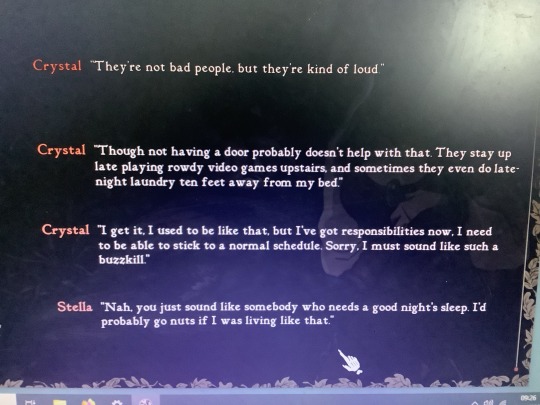
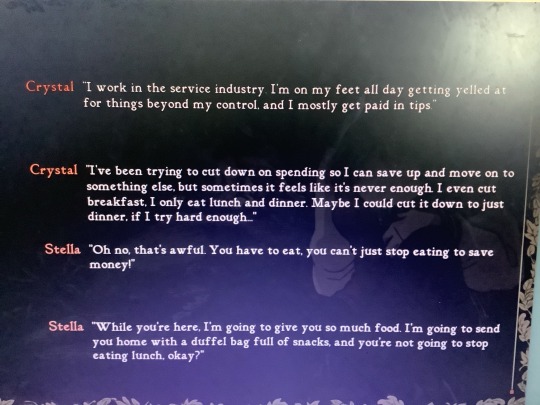
^the moments that made me decide Crystal would be romancing Stella
– On the redacted run, Crystal ended up saving Duke since he saved her life once earlier in the evening, but since she went with Stella for the 2nd run, he ended up more attached to Gretchen and jumped for her (totally not because I realized having neither Gretch nor Tabby in day 4 means I don't get the Stella romance)
– Accepted to stay in with Stella for the night after some convincing
Day 2:
Before anything tho. Gretch


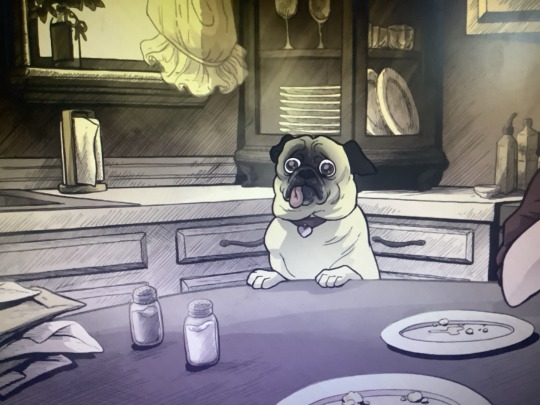
(she singlehandedly convinced me to stick with the second run as the canon one)
– Went straight to the library, not even stopping to catch up with Sybil or Avery and read everything available
– Chose to walk with Stella in hopes to actually talk about what happened, and was glad they did (I got to see the difference between Stella not trusting you enough to do that and opening up, and it's honestly really funny. that girls' Deflection Personified)
– This was actually the first time I took the 'sneaking' part of this segment seriously and did my best to not have Tabby notice them snooping. Also, Street Smarts actually lets you talking to every group of miners without her noticing?!? And give Isaacs your number for an optional scene later?!?! That's so cool and just made me all the more happy with my trait picks for Prisoner
– Didn't warn Tabitha about the kids (Crys was still in 'sneaking' mode), and this was actually a completely new variant for me!! Didn't know Kaneeka went with you as well if Tabby isn't there

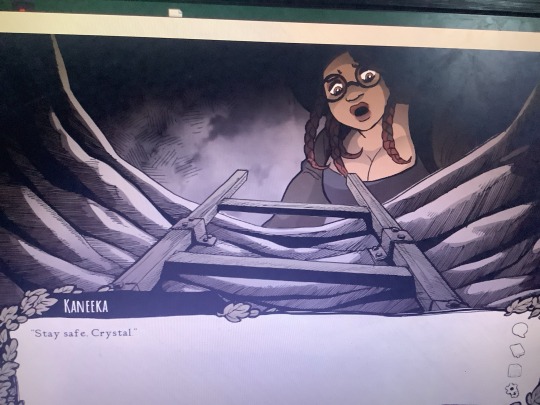
(even in a perilous situation, how is she still so pretty???)
– Despite whay our Book Smarts said, Crys went back for the other kids

(gonna continue in a reblog, getting tired, and tumblr already lagging while I try to type this out lol)
13 notes
·
View notes
Text
i am capital S Shook that the irish red sitter is none other than galina!! i would never have predicted that! since galina only does One Thing in the books, i was sure she was a prime candidate for being absorbed by somebody else; my theory had been that elaida would lead rand's kidnapping personally to give elaida something more to do during midseries when she's not up to much in the books, in part so as not to sideline shohreh. but maybe it's actually preferable to shohreh to only have a main role in her first and last seasons and more of a guest/recurring role in the seasons in between, or maybe they'll bulk up elaida's storyline inside the tower and with alviarin in order to increase elaida's presence during the time between the coup and egwene's kidnapping.
anyway! at the time of watching the cold open i was like "man i wish i was watching this on regular prime x-ray so i could see the names of all the characters in the scene in case these new aes sedai are anyone i would know", but now i'm glad that i didn't find out this was galina until a week later. i liked her! i thought she had a cool vibe! i now feel betrayed (in a good way) to know this is galina! once again wotshow getting an impeccable record in managing to make the antagonists likable even when we know how decisively unlikable their book counterparts are. a very different viewing experience for me than if i'd known straight off this was galina and had therefore gone "oh i've got my eye on you" the second she arrived!
this revelation also increases my hopes that my girl tsutama survived. before, i'd thought that they were two relatively minor reds who might only be needed for this one scene and that their odds of having survived the hallway battle weren't good, especially since we do see red figures dead/unconscious on the floor afterwards. now, i'm certain galina had to have survived because if she was only a random character who's in one scene and dies immediately, they would never have chosen such a loaded name for the character; she's got to be alive. and in turn, tsutama got markedly more focus than galina did in this scene (more lines, more closeup shots), which would be an odd choice if galina is the only one who goes on to become a notable character and tsutama is never seen again after this scene, so i think this is good news for tsutama too. and having tsutama around longer would be a good counterbalance to show that, truly, there ARE some reds who aren't secretly black ajah!
exciting stuff! i have to say, you all know my hatred of WOT Minor Characters and the space they take up, i'm famous for it, but the show continues to do incredibly well at getting even me, their biggest hater, interested and invested in the minor characters. from the moment tsutama and galina arrived, i felt attached to them and wanted to see more of them! (i think being a visual medium also inherently helps with this, since it's easier to feel quick attachment when you have a face and not just a name.) i AM getting a bit "okay, maybe we should slow down" at the number of separate minor characters being introduced, but i trust rafe & co to know their limits and not go over the line with too many characters the way the books did (not least because they have budgetary constraints keeping them in check!). and tower politics is such an important thread throughout the entire series, and having a good number of Specific Aes Sedai We Know can only help with audience investment in that thread, especially since it's a thread that's so often separate from most of our main cast; it needs to include enough strong secondary characters to support it during the times when no primary characters are involved in it.
15 notes
·
View notes
Text
S1E3 – Hard Times Write Up P5 - Friday (One day to the end of the World) up to "the break up"

So, here we are, more than halfway through the episode yet only just getting to the credits. That really threw me the first time I watched this episode! I do think it’s a very clever way to handle the format of this episode though – you couldn’t exactly break the flow of the historical scenes to make way for the credits, and those scenes definitely don’t belong nestled in amongst the main storyline, particularly as all of those scenes were additional material written specifically for the show (as described by Neil in the introduction to the Script Book – this was do with ensuring consistency for seeing Crowley and Aziraphale in every episode of the season). Despite the fact that the storyline covered in these scenes is newly created, the information we learn from them is crucial to understanding the motives, emotions, and thought processes that the angel and demon show throughout the show, and I genuinely don’t think the rest of the episodes, or our relationship with the two main characters, would have been the same without them.
I also think the crazy-fast montage of scenes that we see immediately following the credits is a great way of bringing us back to the main storyline of the show, picking up right where we left off at the end of episode 2, which in fairness does seem like an awfully long time ago – after all, we’ve just been through a whistle-stop tour of 6000 years of history.

The entire sequence takes 5 seconds and appears to use a different image for every frame of film, which means it consists of approximately 130 different tableaus, in chronological order of their appearance in the season. Some editor had fun doing that I’m sure.
Knowing that I should be looking at any instances of writing whenever it’s used, I paused my rewatch of this episode at the point where we’re shown Aziraphale’s little planning board. Whilst most of it makes perfect sense (a map, notes about Adam’s name, relevant prophecy numbers), there is also a sheet of paper covered in writing that, to me at least is completely ineligible:
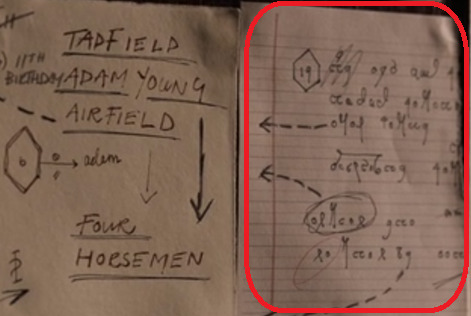
If anybody knows what this writing is, or even if it’s just made-up scribblings to look cool, I’d love to know the answer.
The conversation between Adam and Anathema has always struck me as slightly odd. I mean, it’s nice that Adam stops to ask if she’s OK (when she clearly is not), but there doesn’t appear to be any recognition from either party that they actually met just the day before. And forgive me for imposing modern-day suppositions on to work that was written a few decades previously, but a fully grown adult inviting a kid into their house for something to drink just feels creepy to me. We know she’s perfectly fine to be around though so we’ll let it go. What I do like about the conversation is that there’s an echoing of the exchange that Crowley and Aziraphale shared as they were leaving Tadfield Manor (about angels not being occult but ethereal) but this time the labels in contention are “witch” and “occultist”.
ADAM: Are you a witch? ANATHEMA: No, I’m an occultist.
It’s a nice nod to the notion that words have power. Both parties are describing the same idea but choosing what connotations they want to associate with it. And what’s really important to note on that matter is that changing Anathema’s label completely changes Adam’s opinion of her immediately.
Side note: anybody else find the juxtaposition of some manky old thumbscrews right next to a colourful birthday candle to be a beautifully accurate summation for what an oblivious shitshow the Witchfinder’s Army really is?
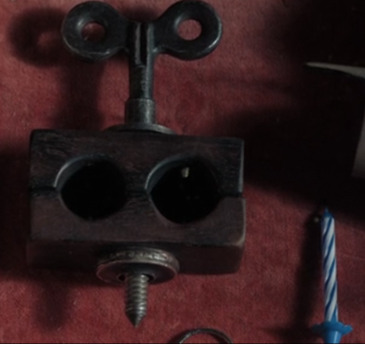
I find the choice of location for Crowley’s meeting with Shadwell to be an interesting one. The café they meet in proudly declares itself to be the “Best Café in Wandsworth”. Wandsworth is a long way from Crouch End, where we know Shadwell lives, and Mayfair, which is where the book states Crowley’s flat is located. And just so we’re covering some of the other possibilities, it’s nowhere near Soho and Aziraphale hasn’t set up the meeting at the 3rd rendezvous point yet for it to be a precursor location for the meeting on the bandstand. Why Wandsworth?
There are a couple of Easter Eggs in Crowley’s newspaper here, and perhaps one on the TV playing in the background. Let’s start with the newspaper. It’s no surprise that Crowley would be reading the Infernal Times, but who knew that demons would consider a bit of hiking for their holidays:

It’s a bit hard to make out, but I’m pretty sure that the headline reads something about walking trails. And it’s a pretty pathetic sounding front page headline:
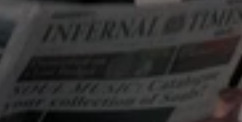
In case you can’t read it (again, it difficult to make out), it says “SOUL MUSIC: Catalogue your collection of Souls?”. As a headline it doesn’t make a great deal of sense, but I think this is probably a reference to Crowley’s soul music collection mentioned in the book.
He was very proud of his collection. It had taken him ages to put together. This was real Soul Music. James Brown wasn’t in it.
The last of the headlines I can actually make out is the following:

Again, if you can’t quite make it out, this one describes some latest research that suggests exorcisms are on the rise in Wales. Just who has done the research, and why specifically concentrating on Wales, remains a mystery. Now let’s have a look at that TV in the corner of the room:
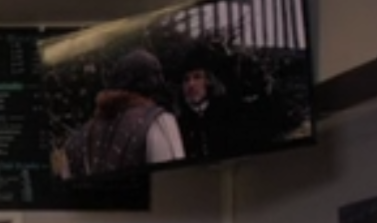
This was really tricky to get a clipping of something that made sense but the footage on the screen looks like it’s set in Puritan times. The guy on the right in this image is even wearing a costume reminiscent of Adultery Pulsifer’s clothes in the previous episode, so perhaps this a witchfinder? I couldn’t get anything concrete, but I think it’s probably a little Easter Egg nonetheless.
It’s nice that we have an acknowledgement of Shadwell’s involvement with Crowley going back decades during the conversation where we discover the demon is sponsoring the Witchfinder’s Army. We know, from the 1967 historical scene, that Crowley has been dealing with this dense oaf for 50 years by this point. I suppose in a show where character recognition, or rather the lack of it (see previous scene with Adam and Anathema, or even the use of the same actors to play different characters as we see in season 2) happens regularly, it was probably necessary to script something that explicitly states that these two characters are aware of the “resemblance” that Crowley bears to someone Shadwell knew many years previously.
Moving back to Anathema and Adam now (this episode does fair rattle through the sub-plot development doesn’t it?!). What’s with the whale obsession please? This isn’t the first time we hear about how whales have big brains (Crowley already raised this point when he was very drunk in episode 1), and it won’t be the last. I mean, I’m not denying that they do have huge brains, I just didn’t realise it was a thing that so many people thought about. I wonder if it’s one of those questions you supposedly can ask men about to get an unexpected response, like how often they think about ancient Rome? Regardless, the whale comment is just one of a bunch of foreshadowing Clues in this scene for later on.

They’ve got it all covered – ley lines, nuclear power stations, the Kraken, Atlantis, and Tibet, all mentioned or seen in a very short space of time. There’s even mention of the destruction of the Brazilian rainforests, something Adam tries to resolve in the book.
Up in Heaven, which looks like an incredibly boring place in my opinion, Aziraphale is busy telling his superiors things they’re either not interested in or already know. I don’t know whether Uriel’s line “what’s happening” is a little reference to Jesus Christ Superstar (the song “What’s the Buzz” uses this phrase repeatedly throughout), but if it is it would effectively put Aziraphale in the role of Jesus, with the archangels being disciples. Not exactly fitting with canon, so maybe this is a little Easter Egg. Or maybe it’s nothing at all.
Whilst I was doing this write up, I noticed that Aziraphale is the only one of the angels to be wearing a patterned garment – his trademark tartan. It’s a nice way to subtly distinguish him, or more precisely his relationship with the concept of free will, from the other angels, and whilst we know he has been exercising his own free will for centuries, his addition of a non-standard item of clothing to angelic attire would suggest he is becoming more comfortable with his stance. Looking back through the historical scenes (including the ones from season 2 we are yet to see), I think the tartan first makes it appearance in 1862, but I’m happy to be corrected on that.
It's a good job that the archangels are a somewhat dense bunch because Aziraphale does not do a good job of hiding when he’s hiding something here. He has a tendency to overact when it comes to the discussion around Crowley, and the pause he puts in before his non-committal answer to Gabriel’s questioning is almost painful.

It should be obvious to them that he’s covering something up but luckily they’re totally oblivious and Aziraphale actually manages to buy himself some time. Credit to him here – he went to Heaven with preconceived ideas of how this conversation was going and he not only manages to adapt to the deviation from his expectations, he also considers what this means, how it changes his plans, comes up with a plan for how to achieve his new objective, and executes that plan very convincingly. There’s a lot of talk about how Aziraphale can often be pretty dense at times, but this little scene should tell you that that’s only really true when it comes to Crowley – outside of the blinkers of friendship and love, this is one quick-thinking and intelligent angel.
We’ve had a couple of mentions of Crowley being “fallen” before now in the show, but I think this is the first time we get any clues as to why that might have been. And surprisingly for such an important piece of information, it’s delivered in an almost nonchalant way.
There was war in Heaven, long before the Earth was created. Crowley and the rest were cast out. Not nothing was ever really settled.
We already knew that Crowley wasn’t the only fallen angel (see Hastur’s comments in episode 2) but this is the first mention of him being involved in all-out war against Heaven. Hastur talks about rebelling in the previous episode, so we can only assume that these are two puzzle pieces that fit together. I don’t know whether season 3 will bring us a fuller answer for Crowley’s fall, but I hope so. I feel like it’s a huge part of his history and who he is; as a fan it would be nice to be able to put it all together for an even better understanding of his character.
Gabriel’s comments about the war and Armageddon make for some interesting discussion points. He says that even though the fallen angels were cast out of Heaven, nothing was settled. What exactly were they hoping would be the outcome of that war? If it was the destruction of those who rebelled, why only cast them out? Why not destroy them at that point? And why exactly does Earth have to get tied up in all of this? His parting line about Earth’s destruction offers little to the debate about what Earth’s role is in the whole Heaven/Hell war, only that Heaven is determined to destroy it, regardless.
The Earth isn’t going to just end itself, you know.
Charming. And unfortunately for Aziraphale, his lack of enthusiasm for another war has triggered the suspicion of the archangels – it’s interesting that he was able to cover his intentions through his talk of Crowley and poorly disguised buying for time but what really makes them think he can’t be trusted is that he clearly isn’t fully on their side when it comes to war.
There is a line in the book about anybody who meets Aziraphale believing him to be “gayer than a tree full of monkeys on nitrous oxide”. I can see how this might have been a little difficult to get into a TV show, but I think the double entendre delivered by the following exchange probably serves as a suitable alternative:
AZIRAPHALE: Do you have any men free? I need them to poke about a bit. SHADWELL: Poke, eh? And where exactly do you want them poking?
And if it wasn’t clear what Shadwell’s thoughts on Aziraphale were, calling him a “great southern pansy can probably fill in the blanks for you.

Remember what I was saying about Aziraphale not being dense earlier? Well this is one of those moments when he proves the exact opposite. He genuinely appears to believe all the stories Shadwell has fed him about the soldiers of the Witchfinder’s Army. I suspect he simply can’t bear to think that somebody would lie to him for financial gain, something which Crowley appeared to be fully conscious of when he dismissed Shadwell’s presentation of the ledger in the café earlier on. Whatever the angel’s reasons for this gullibility, we as the audience can now see that both of our hero pair are not only funding the Witchfinder Army (for the paltry combined sum of £500 per year according to the Script Book) but making use of their services, and hiding the organisation from the other for fear of reprimand. How very Shakespearian.
There are a few little things I’d like to show appreciation for in the Famine scene. First off, and I did have to look this up, but the word “sable” can be defined as “black”. So Famine’s chosen name consists of 2 words that describe black. Given that one of War’s alternative names is Red (or Carmine, which means crimson, as well as her chosen surname of Zingiber, which is another name for ginger – a word you might use to describe a red-headed person), this is hardly surprising. Next up. I love how beautiful the plate of non-existent food in the fine dining restaurant is. I have eaten at a Michelin starred restaurant and I can assure you, that isn’t far off the mark at all.
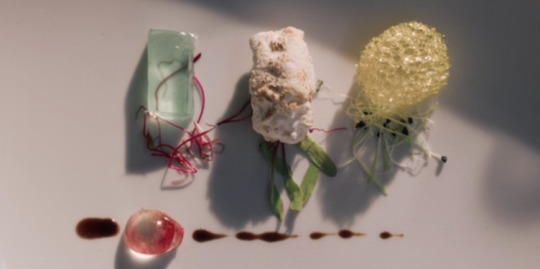
Next little Easter Egg – there’s a picture of the Bentley, albeit in red, on the wall of the burger joint that Famine and his assistant go to:
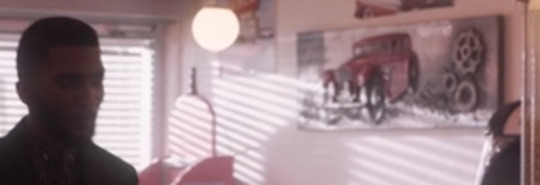
And how many times have we heard/read terms and conditions that sound very similar (scratch that, there are some phrases that are word-for-word perfect) to the ones for Chow for any/all new health product that comes to market with the sole purpose of making money out of gullible/vulnerable people. Neil really nailed the wording and delivery in the script there. Elvis’s presence in the restaurant is a cute bit of humour too, and halfway makes up for one of the lines in the script that didn’t make it to the final cut but made me guffaw like a loon – it’s Death’s response to a question about the year of Elvis’s death from the quiz machine:
I DON’T CARE WHAT IT SAYS. I NEVER LAID A FINGER ON HIM.
Lastly, I’d like to think there’s another instance of script mirroring in the use of the word Chow here. Cast your mind back, all the way to episode 1…
LIGUR: Wassat mean, “Ciao”? HASTUR: It’s Italian. It means “food”.
Except to anyone actually eating Sable’s prized invention Chow isn’t food at all, but eating it might result in you having to say “goodbye” to a lot of things like “hair. And skin tone. And, if you ate enough of it long enough, vital signs.” Beautiful word play.
Side note for the next scene: the Witchfinder Manual actually has a price on the cover (I can’t quite make out what it is, but it’s “old” money), which means at some point that sack of crap was actually sold to people.
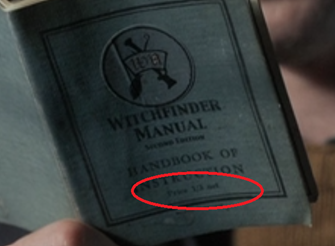
One last tiny note: Crowley tells Aziraphale to meet him at the 3rd alternative rendezvous. Not the 3rd rendezvous or the alternative rendezvous. And Aziraphale can’t remember which location it maps to, though he can list off three possibilities, much to Crowley’s annoyance. I’d quite like to know how many formally named rendezvous locations they have, and why they think that referring to them in “code” prevents their respective superiors from knowing they’re meeting in the first place.
I am going to call it on this part of the write up at this point. I had intended for this part to be the last one for this episode, but I’m already at nearly 3000 words and I haven’t covered the “break-up” scene yet. I think I’m partly just putting off the inevitable by not including it here because I find the last scene of this episode very difficult to watch. Nevertheless, I hope you’ll forgive me. I’d hope I can give that scene the attention it deserves if I split it out into its own write up. So for now… comments, questions, discussion, all welcome, as always.
#good omens#episode analysis#ineffable idiots#good omens season 1#aziraphale#crowley#sergeant shadwell#good omens adam#anathema device#good omens uriel#good omens hastur#good omens ligur#easter eggs#aziraphale loves tartan#good omens book#good omens script book#good omens famine#good omens war#good omens death#witchfinder army
23 notes
·
View notes
Text
Hi I’m gonna rant about Ghost Game for a second
Not to meaning to add to the endless “What the hell happened to Ghost Game????” discourse but uh, yeah I guess I am contributing to that
I have quite a bit to say about my theories on what I think went wrong and what they could’ve done better and why I desperately do not want a season 2 (I know the irony of how that looks on me) but if I wrote all that in one space I think it would be so long that even I would start begging for me to shut up
So, I’m going to split these up into more digestible categories that I’ll write whenever I’m procrastinating
In case I never get around to anything else, I’m going to start with the biggest loss to me, how I think the Digimon were supposed to influence their tamer’s personal growth and visa-versa
I’ll put the rest below the cut before I get outta hand
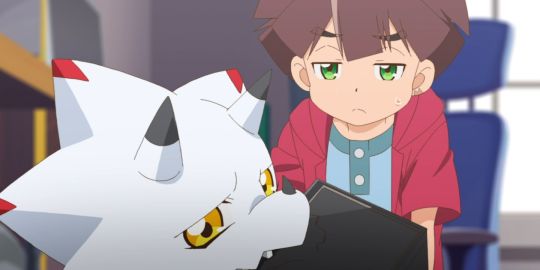
Hiro and Gammamon: Augh. These two frustrate me the most. So much lost potential in my book, but I would feel weird putting the mc anywhere but the top of the list, so I decided to put them in the order they join the cast and therefore you get my most passionate feelings first.
Almost one of the first things we learn about Hiro as a character is how self-sacrificing he is. He’s your stereotypical mc who wants to help everyone, but the narrative points out that he’s willing to be helpful at the expense of his own wellbeing, which paints his conventionally good trait as a flaw. And that’s about all they touch on in the base show, with a lot of reading between the lines. I would’ve loved to see the ramifications of his self-sacrificing nature and have the cast point out how he’s really harming himself and stretching himself thin just to appease others. I don’t think the “being helpful is good, but not at the expense of your health” moral is touched on enough so I always get excited when stories have that as one of their themes.
And then there’s his partner, Gammamon, the exact opposite of Hiro. He’s needy, dependent, wild, and selfish at the start. He doesn’t care about others (or their belongings). He’s demanding. He’s destructive. He proves to be a handful for our polite little Hiro, especially with his dad missing and this responsibility suddenly thrusted upon him.
I would’ve loved to see Gammamon teach Hiro to be a little more selfish (or at least, more self-preserving), while Hiro teaches Gammamon to be more considerate and tame. Of course, we see Gammamon grow in this way but the story doesn’t really make it clear that it was necessarily Hiro’s doing or give much of a catalyst at all for why Gammamon has personal growth other than it would be troublesome to have such a brat as the main creature. Now, I know that Guilmon’s arc was kinda similar in that they didn’t have direct events or anything that would make him mature, but it still felt more… realistic? Tended to? Idk I’m going to force myself to move on.
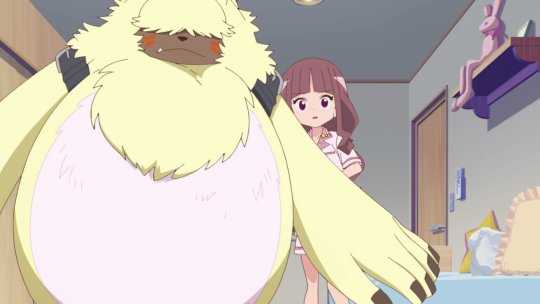
Ruli and Angoramon: Honestly just kinda disappointed with the lack of attention these two got in general in comparison to the other pairs, but I digress.
We meet Ruli with the impression that she’s brash, headstrong, and charismatic. She does things her way on a whim. Especially in the first few and select episodes, but in my opinion, it seemed like they kinda pushed her to the background and her personality was very passive and mild at times (and I don’t think that was on purpose).
Similarly to Hiro and Gammamon, Angoramon has quite a few contrasting personality traits. He’s softspoken, knowledgeable, and introspective. When Hiro first meets Angoramon, he doesn’t want to reveal himself because he’s nervous and doesn’t want to be a bother.
I think these two were supposed to balance each other out. Ruli would learn to think about things more and not run in half-cocked, maybe start to appreciate the more slow and peaceful things in life like nature and reading (Yeah Ruli, don’t think I forgot about that scene where Angoramon wanted you to read one of his favorite books and you DIDN’T and never DID). Meanwhile, Angoramon would come out of his shell more from sticking around Ruli. Possibly learn not to be so overbearing? Idk, honestly I don’t think Angoramon has as much room for growth because he seems the most level-headed character in the cast.
Lastly,
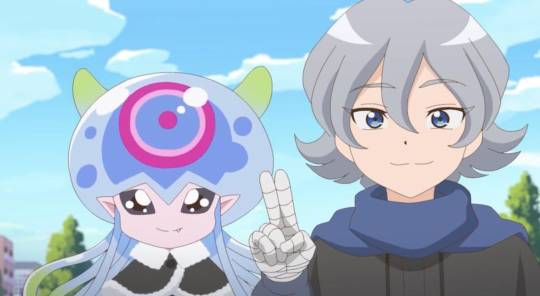
Kiyoshiro and Jellymon: Now, I know I have some bias toward these two so it might seem I’m giving them the benefit of the doubt but I’m going to try to come at them as objectively as I can.
They kinda half-executed what I think they were going for with these two, so they don’t offend me as much (which I think is part of the reason why I like them so much), but a full written out arc between them would’ve been a dream.
Kiyoshiro at the beginning of the series is, well, a sniveling inconsolable scaredy cat. On top of that, he’s kind of cocky and stuck up, obsessed with order and somewhat an introvert (to a lesser extent and differently than angoramon, in the “can’t relate to other humans” kinda way). Outside of his flaws, he is at least kind and pure of heart (I mean his name more or less means “pure white”) with a strong sense of justice and morals.
Jellymon, the devil creature, is so chaotic her intro episode goes right for the “everyone is going to die and it’s all Jellymon’s fault” thing. She has her moments of scheming and kinda like Gammamon, is pretty selfish and demanding with hints of Ruli’s recklessness as well.
As far as their canonic growth goes, Jellymon’s the only one that sees the bravery in her darling, which helps him nurture that courage and cast aside some of his fears (which, yay they actually kinda do in the series albeit pretty indirectly and kinda inconsistently). Also, the narrative never outright says Kiyo is lonely but he surely doesn’t have any companions, but we can see him grow on his partner and admit that it’s nice to have such a close friendship (pretty sure the whole “I like humans” thing was directed at Jellymon, even though she’s not human shhhhh it makes sense I promise)
Now for what they didn’t really touch on, I think these two were supposed to break each other’s stubbornness. I think Jellymon was supposed to show Kiyo how to relax more and not become so absorbed in studies/research and such. We meet him already knowing he has a love for anime, idols and the like so I’m not sure if he could really learn the lesson to appreciate more of the little things, but maybe she’d show him to love some more like, people-centered type things? (I mean she does love festivals). On the flip side, I think Kiyo was supposed to use not his classroom knowledge, but his personal knowledge to show Jellymon all there is to love about humanity outside of their monetary worth and give her a genuine love for the human world. Oh yeah, and teach her to stop scamming people.
“”””I’m gOinG tO tRy To LiMiT mY BiAs oN KiYoSHiRo aNd jElLyMoN”””””””” *Proceeds to spend half my rant talking about Kiyoshiro and Jellymon even though I think they did them pretty well*
Anyway, would love to hear other’s opinions on this as well as if it seems like I’m reaching and there weren’t supposed to be arcs like this. I just feel like the characters are too inherently flawed and contrast too perfectly with their Digimon for them not to have intended some more character-centered personal growth arcs.
I’m sorry and thank you for reading my dumb thoughts.
#digimon#digimon ghost game#ghost game#hiro amanokawa#ruli tsukiyono#kiyoshiro higashimitarai#gammamon#angoramon#jellymon#text post#wall of text#fandom analysis
18 notes
·
View notes
Text
I was allowed the chance to read a friend's ARC of her debut novel and finished it today. Here's my review and I heartily recommend it for those who like BL and/or pining idiots:
Cross the Line by Lucky Hart My rating: 5 of 5 stars (ARC Review) My favorite things to read tend to run to mystery, action, and suspense, whether in a modern, historical, or fantasy setting. Romance for the sake of romance is not my first choice in picking up a book. But the things my favorite fiction has across genres tend to come down to interesting and compelling characters. "Crossing the Line" has these characters in spades. They leap off the page, vibrant and alive, with a richness of details in their appearances and personalities that will have one nodding, yes, I feel like that or yes, I know someone like that. Having these characters paired with dialogue that flows naturally from one character to the other means that scenes are engaging and keep you in the story. There were plenty of times in the past week where I stayed up past my recommended bedtime to finish just one or two more chapters, or was thinking about where the story might go when I couldn't be reading. Theo and Alec, the main characters, are nicely rounded. They both have things they excel at. They have core personalities that don't waver much as the plot progresses. They have challenges and traumas, but these things neither define the characters nor act as maguffins, only appearing in order to move the plot or cause a conflict. And they are surrounded by other interesting characters in Alec's brothers and friends that enhance the story rather than distract. One of my two wants for this book is to have more women appear on the page rather than just talked about. I can see the attraction of writing the Kings as a boisterous family with four sons and they are all fun characters, but we only get a few glimpses of Mom and mentions of a beloved but deceased grandmother. Yes, Alec being on an NCAA soccer team means being surrounded by other guys, but to not have even one girl among the student population that became a friend feels unlikely. I hope future installments of the series will include a few women with the same kind of loving depth that is shown for the characters here. The plot hinges on feelings, attraction and desire crashing up against friendship and loyalty, and it's delightfully messy just like real life can be. The circumstances in which Alec and Theo keep meeting and then avoiding include decisions, both good and bad, coming from their personality traits and outside circumstances like horrible timing or being in the wrong place. It produces a good balance of emotional exploration with the occasional sitcom-level comedy bit that had me groaning of course that happened. As things move into dangerous waters for our heroes, they take responsibility for one another because they care about each other that much. Even if neither of them has quite figured it out yet, because they are complete pining idiots. My second want for this book, because the characters are so lively, was to have a little more in the denouement department. To read the conversations between a few different characters and the process of some decisions made instead of having them summarized in the epilogue. But that's a testament to how much the characters and story drew me in that I wanted more of them. I finished this book feeling satisfied and entertained. I will read it again. I want to read the next book in the author's planned series. I would recommend it to anyone who likes modern-day romances where you want to reach into the screen and knock the love interests' heads together so they figure it all out or stop keeping their feelings secret. If you're uncertain about smut, there's only three sequences where it's featured and even then the characters are mostly busy talking or feeling things. Take a chance on this one and see if it crosses the line into one of your favorites.
6 notes
·
View notes
Text
Top 5 Portrayals of Sebastian Moran
This is our penultimate little list for the primary supporting figures in the universe of Sherlock Holmes. We’ve gone over his greatest allies, and one of his greatest adversaries: Irene Adler, whom I declared to be probably Sherlock’s second most notable opponent after Professor Moriarty. While this is true in terms of popularity and impact, there’s one other character who arguably fits this bill even better in the books: the man Holmes declares to be “the second most dangerous man in London,” and, going with the “second” theme, acts as Moriarty’s chief lieutenant. I speak, of course, of Colonel Sebastian Moran.
Moran’s genesis is an interesting one, as it is intrinsically linked with his master, Moriarty. After deciding to bring Holmes back following the events of “The Final Problem,” Conan Doyle had to figure out how to manage it. Bringing Holmes himself to the land of the living again was relatively easy - he’d laid the groundwork for that by making the actual demise of Holmes out as Watson’s presumption, in the way it was written - but just as he needed an enemy powerful enough to snuff out Sherlock’s light in the first place, he needed another opponent who would be worth the great detective’s trouble to step out of the shadows and back into the limelight again. So, in “The Empty House,” he invented Moran: Moriarty’s second-in-command, and the closest thing the Professor ever had to a friend. So loyal he will stop at nothing to kill Holmes, even after Moriarty has been dead for a few good years. A disgraced soldier and expert sniper, whose origins are as shrouded in mystery as Moriarty’s own. While Moran is not as popular as Irene Adler, or his well-known employer, he has remained fairly persistent throughout interpretations of the Holmes canon. He’s even had a few versions where he’s totally separate from Moriarty, surprisingly. But which ones are the best? (pauses) I have no idea, but here’s a few I like, at least. These are My Top 5 Portrayals of Sebastian Moran!

5. Vinnie Jones, from Elementary.
In this series, Vinnie Jones (keep your Juggernaut jokes to yourself) plays a rather different version of Moran. Instead of being Moriarty’s loyal right-hand man, this take on the colonel is a killer-for-hire, who eventually turns against his mysterious employer. He is somewhat more sympathetic than other versions of Moran, as it is ultimately revealed Moriarty has gained hold over him by threatening his family.
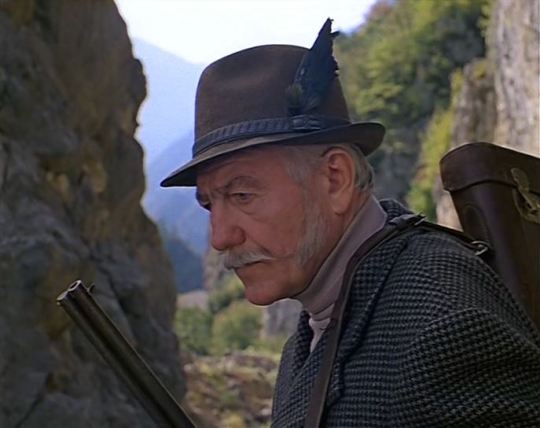
4. Nikolai Kryukov, from The Adventures of Sherlock Holmes & Dr. Watson.
This somewhat older take on Moran first appears in “The Deadly Fight” (the Russian series’ adaptation of “The Final Problem”), and secretly helps the Professor out behind the scenes, sniping at Holmes and seemingly killing him after Sherlock defeats Moriarty. In “The Tiger Hunt,” the show’s adaptation of “The Empty House,” Moran returns as the main antagonist, baffling Dr. Watson before ultimately being defeated by the “resurrected” Holmes.
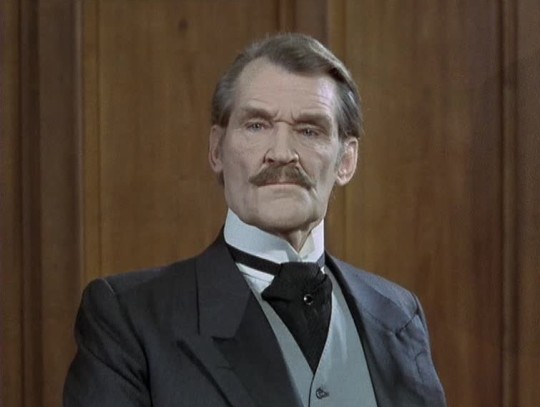
3. Patrick Allen, from the Granada Series.
Allen is a more-or-less “by the book” Moran, which is both his greatest pro and greatest con. He’s the most accurate to the source, but I think a couple versions above him, which go a bit beyond that, are simply more interesting. This version keeps Moran’s identity as a villain a secret for a while, and I love the dichotomy between his more “crusty but seemingly jovial” demeanor before the reveal, and his absolutely fiery, unhinged wickedness when his true nature is brought to light. The anger he exhibits when he goes after Holmes is especially striking: clearly, these two have a history as much as Moriarty and Sherlock do. So much is done with so little, and I applaud this version for that.
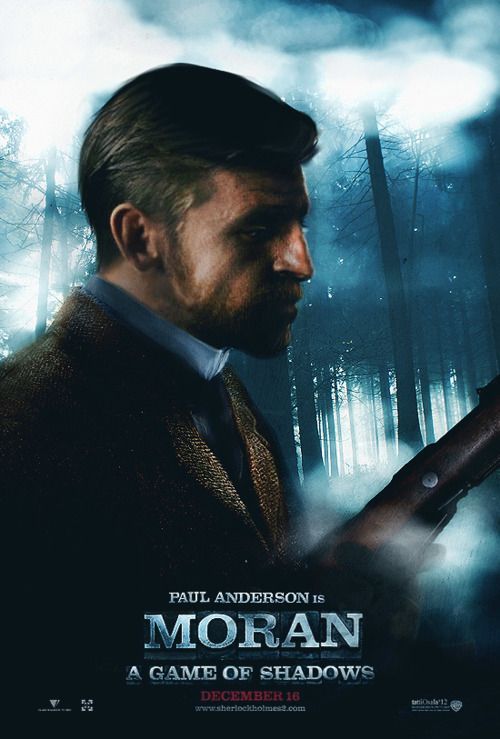
2. Paul Anderson, from the Guy Ritchie Films.
Anderson’s version is interesting in that he acts as a sort of dark parallel to Dr. Watson, just as Moriarty acts as a sort of dark parallel to Sherlock Holmes. This is a concept no one has really touched on before or since, and I think it’s a fascinating one. Anderson’s Moran is just as faithful as Watson (if not, arguably, more so), and, like the good doctor, has military experience to back him up. But while Watson questions Sherlock’s bad behavior at times, and acts as an anchor of sanity, Moran goes along with anything Moriarty does without question or remorse, and seems to enjoy it all just as much. He was honestly just as memorable for me as Harris’ take on the Professor.

1. The Version from Moriarty the Patriot.
Like so many other characters in this anime, this version of Moran takes what was in the book, pluses it, and adds many new flourishes. Just like his boss, Moriarty, Moran is reinterpreted not as a villain but instead as an anti-hero. He’s still a gambler, still a sniper, and can be exceptionally cold-blooded when the chips are down, but instead of being a criminal monster, he’s someone trying to find a new purpose in life, facing demons from his past and seeking to do some good. He’s even more fascinating in the manga than the anime, for the record; in the latter, he’s played by Satoshi Hino in Japanese, and Christopher Wehkamp in the English dub. Incidentally, I’ve actually gotten Wehkamp’s autograph: nice fellow!
#list#countdown#best#favorites#top 5#actors#acting#film#tv#movies#animation#sebastian moran#sebastian#moran#sherlock holmes#moriarty the patriot#elementary
15 notes
·
View notes
Text
A Botanical Daughter by Noah Medlock
Genres: historical fantasy, horror, queer romance Rating: 8/10 Spoiler-free review: This book was a lot of fun! I really enjoyed reading about people who live in a glasshouse botanical garden – I love botanical gardens and this is such a whimsical and magical premise. There was not that much horror but the gory scenes really stood out and will probably stay in my memory for a while. The theme of found family is well-integrated into the story and I was rooting for the main characters until the very end, even through their very questionable actions. The prose is delightful and enjoyable to read. My only complaints are that the ending was rather abrupt and kind of anticlimactic and I feel like the relationship between the two protagonists could have been developed more. Overall, a great read.
Spoilers under the cut
Oh boy, I need to organize my thoughts. Well first of all, as a fan of all things Frankenstein-inspired, A+ on the creature. I love when Frankenstein-inspired/retelling books twist the original premise a bit and have the creature be cared for by its creators. In this book, the creature is actually treated like a daughter by the two protagonists, and as a close friend first and then a lover by the side character, Jennifer (or is Jennifer the third protagonist?). Although some of them are scared of the creature Chloe for some of the time, they still treat her with respect up until the end. That was a refreshing take! A similar thing happens in another Frankenstein retelling I read recently, “Our Hideous Progeny” – check it out if you like this subgenre as well.
Second, I don’t know how I feel about Simon’s and Gregor’s relationship. At times it was hard to understand why are they together in the first place, especially later in the book when Gregor starts acting more and more like an asshole. Simon is kind of autistic coded so I understand why he isn’t very expressive or emotional (same tbh) but Gregor is also rather distant and cold. I guess they are a typical Victorian couple. A funny if a bit perplexing aspect of this book is how Jenny doesn’t realize for a while that Gregor and Simon are a couple, and Simon and Gregor don’t realize that Jenny is in love with Chloe (or that she was in love with Constance). Gregor in general is kind of an unlikable character, but I love reading about assholes so I was on board with it.
Third, I did not like the ending very much. It felt rather abrupt and kind of out of nowhere. I knew the plot was going in the direction of Jenny running away with Chloe for some time, but I feel like Jenny’s relationship with Chloe did not have enough room to develop and the sex scene happened out of nowhere. The sex scene itself is great, I just feel like the plot jumped a few steps in regards to their connection. It makes sense that Chloe killed Jenny in the end (not really her fault, I don’t think the mycelium fully understands the difference between life and death), but I thought it was a bit cruel to then lock the mycelium in another glasshouse. I don’t know what the alternative would be – perhaps the mycelium escaping would be much worse – but the way it is, I felt sad for the mycelium. Maybe I root for villains too much, who knows.
Overall though, this is a great book and a highly recommend it! I will be checking out whatever the author writes next for sure.
#a botanical daughter#book review#book recommendations#readblr#bookblr#should i write a review for our hideous progeny as well?
4 notes
·
View notes
Text
The Forest of Stolen Girls
By June Hur
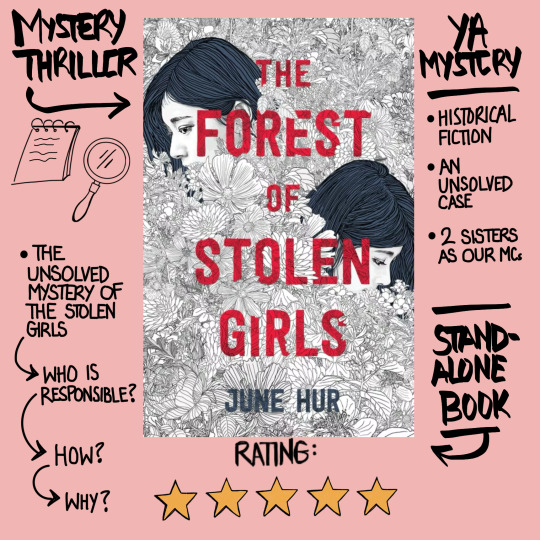
Rating: 5/5⭐️
This was the second book by June Hur that I read and it did not disappoint!
Quick Summary:
Set in the Joseon Dynasty, the case of the missing girls, or the stolen girls as they have come to be called is one that has long followed Hwani's family.
From having been found at the scene of a crime along with her sister, to the disappearance of her father, Detective Min, who had vanished whilst last pursuing the case, such a case has become personal to Hwani.
She returns home to Jeju island determined to put all the pieces together and finally find her father. Along the way, she will encounter and uncover facts and figures she'd rather not face, including an estranged sister. To finally make sense of it all, the buried secrets and fragmented memories of the past must resurface in order to solve this case once and for all.
Thoughts:
This book in my opinion, especially in comparison to Hur's book 'The Red Palace', which I had read prior to this, provides a more eerie and creepy atmosphere.
The mystery had me hooked from the start, and made me question each and every character introduction with each turn of the page. The action scenes in particular or should I say more of the chase scenes, had me on the edge of my seat. As a reader I was able to feel and empathize with the characters and situations presented before me. I think the fact that this book took inspiration from actual historical events within Korean history greatly influenced the level of intensity that certain scenes carried.
Our main characters, the two sisters Hwani and Maewol, felt so real and distinguishable amongst a set of characters introduced throughout the book, from suspects to friends and foe. Personally, I'd say the relationship development between the sisters was one of the highlights of the book. The complex sibling relationship felt so authentic, that fluctuation between not being able to stand each other at times with their shared trauma and years of separation, but also when it came down to it, still choosing each other.
Having started this book with my memories of the 'The Red Palace' still fresh and to almost hold in comparison, I was so glad to find that this book was able to hold its own. One difference I personally took note of was the lack of a romance subplot. As someone whose never quite taken to romance novels I tend to prefer romance as more of a subplot. This was something I greatly enjoyed in 'The Red Palace' and was honestly a tad bit nervous that this was something 'The Forest of Stolen Girls' would be missing.
In retrospect, I truly had nothing to fear. The mystery and thrill of the book, paired with elements of familial love and secrets were more than enough to have me finishing this book in 2 days (I would've finished the book in one sitting but sleep is still a necessity).
Suffice to say, this is another book I'd gladly add to my own personal collection and would highly recommend to anyone interested in mystery and historical fiction. In fact, if you're not a big fan of any of the genres mentioned but are still curious, I'd still recommend reading.
#book reviews#the forest of stolen girls#june hur#book thoughts#the red palace#book review#bookworm#books#bookish#booklr#mystery books#murder mystery#historical fiction#korean books#ya books#young adult books#young adult fiction#young adult
3 notes
·
View notes
Text
Wuthering Heights by Emily Brontë - Book review
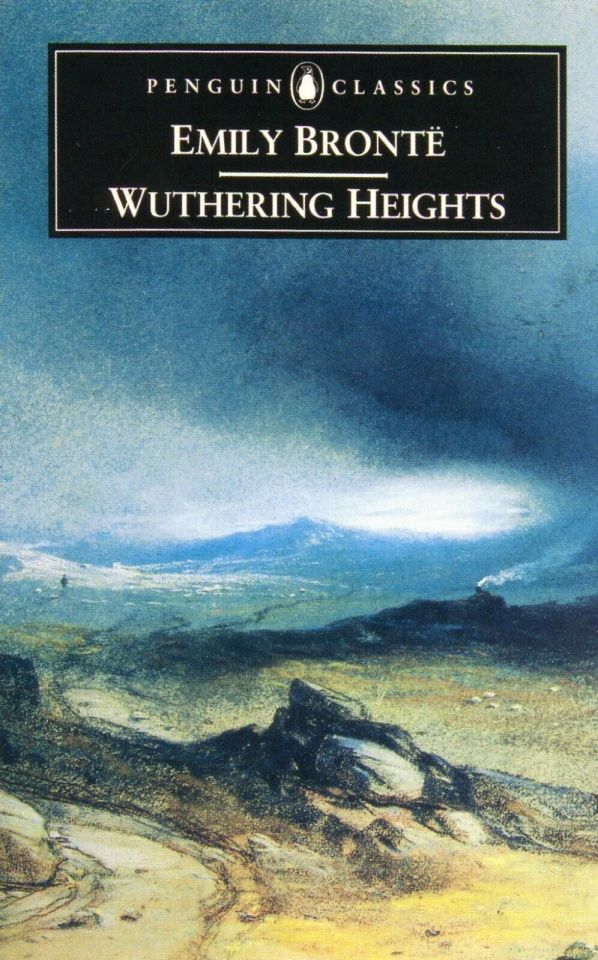
Rating: 5/5. This was definitely one of my favourite books of all time, here's why...
I started reading this book in March of 2022 but stopped after reading two chapters, mostly because I felt really intimidated by the language (as English is not my first language). So I soft-DNFed it, and I'm glad I did because I was 100% not ready to read it then. I wasn't ready for the language, nor was I ready for the contents of this wonderful book. I came back to Wuthering Heights in January 2024 after a friend convinced me to read it, and I loved it. I read the book in a week (while balancing school and such). The English is not easy, but it wasn't as scary as I thought it would be. I could understand it without too many problems, and I'd say It was a pretty smooth read.
Short, spoiler-free summary: Wuthering Heights is a classic gothic novel by Emily Bronte that follows the love story (Although it's debatable if you can even call it a love story) between Catherine Earnshaw and Heathcliff. The novel is set in Yorkshire, England, and includes themes of passion, revenge, and redemption. Cathy and Heathcliff are forced to struggle against the harsh environment and social constraints of their time, and it all leads to tragedy. It also takes place over several decades (1770-1803ish).
What I liked (Spoiler-free): Now as I'm just starting this blog, I'm reviewing books I read a while ago so my memory isn't super refreshed and they won't be that long and detailed, but I'll post more reviews of books I recently finished after I get the hang of this.
Anyway, my thoughts. If you love a dramatic book that'll keep you entertained but also still be well-written enough to resonate with you when you're finished (and while you read), this is the book for you. To me, there wasn't a single boring moment in the book-- not even the start, which is usually fairly boring as you're trying to get into the story and you know nothing about anyone.
In the opening scene, the book already manages to create a sense of dread and suspense. From describing the melancholic and harsh environment of the moors to the shady actions of the main characters, it all gives you a great idea of where the story is heading.
The dialogue is very lively, though unrealistic (In today's standard anyway, who knows they might've been this dramatic in the 18th and 19th century...) but you will not get bored whenever you read the monologues or dialogues. I also found it very poetic at times, so the dialogue wasn't just entertaining but also very beautiful at times.
Its characters are deeply flawed, and that's what makes it so good. You might relate to Heathcliff for one second and be completely horrified by his actions in the other. They're realistic and human, they're not completely evil or completely good. They are driven (the two main characters specifically) by passion, but they are also stubborn, ambitious, and selfish, which leads them to make mistakes that have dire consequences. The other characters also react very naturally to the events that happen, especially our narrator Nelly, Cathy and Heathcliff's old nurse. But I'd say that the main characters are well-developed, with a clear and consistent arc throughout the story that showcases their transformation into tortured souls.
The novel's pacing is slow and deliberate, building up to the dramatic and explosive climax that reveals the extent of the characters' devotion to each other. But despite the slow pacing, the story stays very entertaining so you won't feel it drag on once/if you're really immersed-- so no I wouldn't call this a quick read you can squeeze in to get to your reading goal or a book you can have in your bag to read a few pages whenever. The experience would be better if you sat down and took your time, and it's truly an experience.
When it comes to tropes, the book is reliant on classic tropes of Gothic fiction, like an eerie and isolated setting, supernatural elements ("Ghosts" and stuff), and the presence of a (usually class-related) forbidden romance.
What I liked (Spoilers): My God this book was soul-wrenching!! The dialogue was gorgeous and poetic, whenever Cathy and Heathcliff talked about each other I was always moved. The part that really got me to get into the book was in volume 1, chapter 3 when Heathcliff almost throws himself out of the window screaming for Cathy after Lockwood told him that he thought a ghost was begging to be let in. The entire dialogue between Cathy and Nelly where Cathy confessed her love for Heathcliff was of course the most memorable and the one everyone mentions the most, and I definitely understand why as it's beautifully written and full of emotions. But my favourite parts (No I can't choose between them) of this book were 100%
When Heathcliff returned after disappearing for years. His reunion with Cathy was so passionate that I almost cried, and the dialogue, the "You have killed me and thrive on it." -- "You have killed yourself... I have not broken your heart, you have broken it, and in breaking it, you have broken mine... I forgive what you have done to me. I love my murderer, but yours! How can I?" (Volume 2, chapter 1) oh my GOD I was floored. Amazing.
When Heathcliff found out Cathy was dead after childbirth and lashed out. "Catherine Earnshaw, may you not rest, as long as I am living! You said I killed you, haunt me then! The murdered do haunt their murderers. I believe, I know that ghosts have wandered on earth. Be with me always, take any form, drive me mad! Only do not leave me in this abyss, where I cannot find you! ...I cannot live without my life! I cannot live without my soul!" (Volume 2, Chapter 2) I mean if you put the sheer beauty of it aside, you can really see how corrupt and dark these characters are.
What I didn't like (Spoiler free): To be honest there wasn't much I didn't like about this book other than the fact that it was really hard to understand what Joseph was saying because he spoke in an accent and Bronte kind of wrote everything he said phonetically. But this could be made easier if you listen to a British-speaking audiobook while you read because it's easier to understand what he's saying when you're listening to someone British reading it out loud. I recommend this audiobook, it was very fun. (Slight spoilers now, but not really, but I'm putting this to be safe) I also would've kind of liked it if they explored the paranormal aspect of the story more, like the ghost stuff was only mentioned like twice and I think it would've given the book more of a gothic flare if she continued haunting him both mentally and physically. But it's not really something that would ruin the book for me.
My favourite quote would probably be: "In every cloud, in every tree-- filling the air at night, and caught by glimpses in every object, by day I am surrounded with her image! The most ordinary faces of me, and women-- my own features-- mock me with a resemblance. The entire world is a dreadful collection of memoranda that she did exist and that I have lost her!" (Volume 2, chapter 14)
Reasons why you might not enjoy it:
Complex language, this was written in the 19th century and uses language that may be difficult to understand for some readers. Don't feel bad, I was 'readers' when I picked it up for the first time.
Slow pacing, the book's pacing is slow and intense, which may not be to everyone's taste. You may find it difficult to get invested in the story.
Dark themes, the story is pretty dark, some might say a bit too dark so that might be a reason you might not like it if you're not into that.
Unlikeable characters, they're not meant to be likable but they can irritate you and ruin your reading experience (I'm looking at you Linton Jr)
Similar book(s) you might like after (that I personally liked):
Jane Eyre by Charlotte Bronte.
So if you're interested in Gothic literature or simply enjoy exploring the complexities of human nature, this book is a must-read.
#academia#penguin classics#literature#english literature#book review#emily bronte#wuthering heights#reading#currently reading#heathcliff#great books#favourite books#booklr#book blog#bookworm#bookish#books#bookblr#books and reading#oh my god i love this book#romantic goth#goth#gothic art#literary quotes#new poets society#dark academia
6 notes
·
View notes
Text
The first two episodes of The Acolyte came out this week, and I loved them. The latest Star Wars show is great. It’s 100% for me.
I’ve been really excited for this show ever since it was announced that it would be set in The High Republic Era of Star Wars. I’ve been a huge fan of the publishing initiative in the books, comics, manga, and audio books. The story and characters have been intriguing and I can’t wait to see how it wraps up in 2025.
With The Acolyte set 100+ years after the events after the books and comics, Leslye Headland has a somewhat blank canvas to do whatever she wants in this story. Things are exciting!
I was thrilled that they jumped out almost as fast as they possibly could with revealing that Amandla Stenberg was playing two characters in Mae and Osha. They didn’t let that linger in as a mystery at all.
So, what’s the story here…
The misdirection in the marketing was that this show would be about the mystery of somebody murdering Jedi, but we quickly learn that is not a mystery at all. We know immediately who has done the killing, and all of our main characters learn pretty quickly as well.
No, our mystery is the reason that Mae is targeting Indara (Carrie-Anne Moss), Torbin (Dean-Charles Chapman), Kelnacca (Joonas Suotamo), and Sol (Lee Jung-jae). What happened 16 years ago when they visited the village of Mae and Osha? It certainly feels like the Jedi screwed up here… Somehow. I can’t wait to see how
The opening fight scene between Mae and Indara was breathtaking. I loved that Indara didn’t reach for her lightsaber until the last possible moment. The choreography was beautiful, and it was shown again later in the night between Mae and Sol. Indara and Sol coolly and calmly handling Mae was fun to see.
I want to hit on some of the Jedi characters that we got here:
Sol: Watching him be in complete control of all of his emotions except with regards to Mae, Osha, and the night of the fire, certainly leads me to believe that we’re being misled about what actually happened.
Indara: Carrie-Anne Moss gave off “Jedi Master” vibes immediately. The opening fight scene was spectacular. I’m excited to see the flashback scenes to see the younger version of her.
Yord: I love that we got a straight-laced, by-the-book Jedi. He feels straight out of the Ki-Adi Mundi lineage. It felt like he was easing into the “Ok, sometimes things aren’t black and white.” line of thinking. I’m really interested to watch his development.
Jecki: She was funny. I like funny Padawans. I like how confident she was in her first mission. There was a recent video clip of Dave Filoni talking about how, when they were making The Clone Wars, they were going to make Ahsoka out of her depth in her first mission, but George Lucas was like, “Why would she be out of her depth in her first mission? She’s Jedi. This is what she’s trained for her entire life.”
Vernestra: I’ve seen some minor complaints that she’s different than she’s been in the books set during The High Republic, and… Yeah? It’s been 100 years, and she’s no longer a 16 year old girl. Why is this shocking? She’s seen some shit.
I can’t wait to find out more about Kelnacca in the next episode.
Let’s get to the second mystery? Qimir is 100% the Sith apprentice that’s training Mae to be his acolyte, right? It’s the most logical. The way he changed when speaking to Osha was weird and creepy. He’s definitely “Darth Teeth” (I can’t wait to find out his name.).
I really liked these first two episodes of The Acolyte, and I can’t wait for me.
#amandla stenberg#carrie anne moss#charlie barnett#dafne keen#dean charles chapman#indara#jecki lon#joonas suotamo#kelnacca#lee jung jae#mae aniseya#manny jacinto#qimir#osha aniseya#sol#rebecca henderson#Star wars#the high republic#high Republic#star wars high republic#the acolyte#Acolyte#torbin#tv#tv review#vernestra rwoh#yord fandar#Jedi#Jedi order
4 notes
·
View notes
Text
Get to know your fanfic writer
Thanks @jamilas-pen for the tag!
When did you post your first ever fanfic?
It would have been some time in early 2005 on Fanfiction.net
I’d essentially been writing fanfiction in notebooks in the 90s but before then our computer was in a shared computer room and we had 30 minutes of dial up allowance per sibling per day so I never browsed the internet enough to understand what fanfiction was and that people would want to read things. I was just having fun!
Then Livejournal (and later AO3) happened and the rest, as they say, was history.
First Character(s) you wrote for?
Ash and Misty in Pokémon (largely unpublished and just for fun until 2007) and then my first published fanfic was for Paine and Nooj from Final Fantasy X-2
Main character(s) you’re currently writing for:
I do still love a bit of Pokémon fanfiction. But mainly nowadays I’m writing David/Patrick (Schitt’s Creek), Nick/Charlie (Heartstopper) and, occasionally, Tim/Lucy (The Rookie). I’m also working through a very long (for me) story based on a series of books I read as a child (Animal Ark) so we can add Mandy Hope and James Hunter to the list even if I take massive hiatuses on it.
I have severe ADHD though so I tend to be very flighty with fandoms. The ones that have stuck around are ones that I have essentially trauma bonded myself to (I can date my periods of stress to when a particular piece of media came out because I’m still obsessed with it decades later!)
Character(s) you haven’t written about before but plan on writing about soon:
I’m not sure there are any… I tend to just throw myself in!
EDIT: I never did write the Basil/Polly Fawlty Towers fic I outlined in 2010 while camping at work when I was snowed in. I have also considered writing a Daphne/Niles Frasier fic but have never got round to it. Because I am 50 at heart.
Fandom(s) you’re currently writing for:
Schitt’s Creek
Heartstopper
Pokémon
Animal Ark
Platonic pairing(s) you currently write for:
I don’t tend to write a lot of platonic stuff. I did enjoy recently writing Patrick Brewer & Ronnie. I have also been known to write tiny snippet stories set in the Discworld and they always involve something platonic.
Romantic pairing(s) you currently write for:
Nick/Charlie
David/Patrick
Ash/Misty
James Hunter/Mandy Hope
Your top 3 tags on AO3 (if you post your works on AO3):
Friends to lovers
Canon compliant
Drabble
Your current platform where you post your works:
AO3
Post something from a wip:
I’m stuck on a scene that needs to go between the most recently published one and this one so have a random scene from the Animal Ark fanfiction that I am writing purely for my own enjoyment:
The photo he had landed on was one she hadn't seen in years; she remembered when she flicked through the facebook album when they got home that it hadn't even registered as something she should dwell on, the trip had been full of too much safari excitement. But now… she dwelled. The two of them were sat, questionably close, on a bed in a wood panelled hotel room; his chin propped up on her shoulder as they read a book together- the title had been lost to memory- and his arm braced behind her. She remembered a kid from their travel party, young and excitable like she had once been, taking the photo before either of them realised she was there and it ending up nestled in a photo album that was otherwise posed and purposeful. A little secret anomaly. After, when the flash had made them jump and they broke apart, she remembered the feeling of guilt, of being caught in the act of something that she couldn't quite identify. He hadn't ever come away with them again, life had got busier, and she never told him about the hot, quivering feeling that had overtaken her in the seconds before they were interrupted. How, if he had come just a little closer, she would have closed the gap and kissed him. It would have been a first for both of them, and it would have been clumsy and awkward, but she would have done it without a moment’s hesitation if she hadn't been startled by that camera. She had forgotten about it, truthfully, for a long time, but now the memory of that unfamiliar heat rising up in came flooding back when he stepped closer to her.
And, just in case, another from a little Heartstopper scene I started in lieu of getting up and doing anything productive at 8am this morning:
Charlie’s voice, more like music in his ear than the sounds he had just created, played somewhere nearby. Close, but not close enough until he stepped forward and peered down at Nick. From this angle, the glow of the neon sign cast shadows across the angles of his face; highlighted the fullness of his lips in a way that made Nick feel hot. He looked away, tried to inject something that would sound like humour in to his voice.
“I’m trying!”
“Here, budge up, let me help.”
I always feel awkward about tagging anyone so, I tag anyone who wants to answer!
8 notes
·
View notes
Text
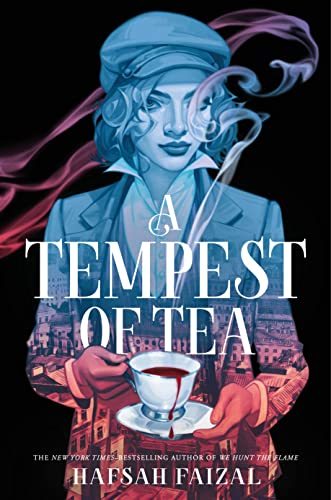
Read 2/1-2/2
Four Stars
I enjoyed Hafsah Faizal's previous duology The Sands of Arawiya and I have been eagerly anticipating A Tempest of Tea since its announcement several years ago. I always feel a little trepidation when books are compared to Six of Crows, it just became so popular that any book with even a hint of a heist had Six of Crows slapped on as a comp title. A Tempest of Tea really delivered in the right ways for me. There's a heist, there's a lovable but morally gray crew, and there's some fun twists throughout the way. Add in some vampires and I'm fully sold on the concept of this book!
Arthie was a great protagonist. She is the owner of a tea shop that is often on the wrong side of the law due to nature of the tea she sells. Arthie is a lot of fun, she's highly intelligent and always have a trick up her sleeve. One of the first few scenes of the book where we see her outwitting the people ransacking her shop was so tense and I adored seeing her smarts shine through so early on. I also enjoyed slowly discovering her secrets throughout the book, although I do feel there was a twist that felt quite easy to spot early on. I really enjoyed Jin, Arthie's adoptive brother. He's a charmer and I loved all his interactions with another major character, Flick. Flick's storyline was maybe my favorite of the main characters. I really enjoyed her growth throughout the book. Rounding out the our heist crew are Matteo and Laith. I have opinions on both but they're quite spoilery so I'll have to simply stop at they exist you'll have to form your own opinions about them.
While the majority of this was very fast paced there were a few moments where I felt the flow of the story got a little odd and moments that dragged despite the action that was happening. I was also just not into Arthie's romance in this book. I felt like it occurred way too quickly and did not feel organic at all. While I wouldn't classify this currently as having a love triangle because one of the character's interest did not read as anything more than lightly flirty for most of the book, I do think at the end there are two characters who seem to be set up as potentially both being love interests for Arthie in the next book. In contrast I was 100% here for every interaction between Jin and Flick and I do honestly think the book would have read much better if they were the only characters displaying romantic feelings, at least in this installment. Part of that is because Jin and Flick are shown to have a history that Arthie simply did not have with the characters set up to be her partner. I would have needed more time and slower development to even start to believe in Arthie's romance.
All in all this was a great read and I had lots of fun. I cannot wait for the second book!
2 notes
·
View notes